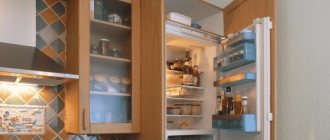A little about the design of the refrigerator
The operating principle of a household refrigerator is to remove heat from its insulated working chamber to the outside. As a result, the air temperature inside the refrigerator drops, and the heat removed outside is dissipated in the surrounding space.
The process takes place using special spirals. The aluminum coil inside the refrigerator compartment, called the evaporator, is filled with a refrigerant that can absorb and evaporate heat.
On the outside of the chamber, on the back wall or under the outer metal casing, there is another spiral - a capacitor. This is an external heat exchanger that transfers the incoming heat to the surrounding air. This is why the side walls of the device heat up.
The compressor, located below, ensures the operation of the entire cooling system: its piston cyclically distills the refrigerant through spirals, forcing it to pass from a gaseous state to a liquid state and back.
Distance from the refrigerator to the wall or other objects
The principle of operation of the device is such that for normal functioning it requires free circulation of air around its body . Otherwise, the refrigerant in the condenser will not cool to the required temperature, and the device itself will begin to overheat. The compressor also requires cooling.
Important! The refrigerator cannot be placed close to the wall. This will lead to improper operation of the cooling system and damage to the compressor or other elements.
The amount of clearance required for air circulation depends on the model of the device and the location of the condenser. This information can be found in the installation and operating instructions for the device.
In most cases, standard minimum clearances are:
- top – 100 mm;
- on the sides – 50 mm;
- rear – 50 mm.
In some models, the capacitor is located at the bottom of the device - under the bottom of the working chamber. In this case, a gap is required between the floor and the body (adjustable with legs). At the top, on the back wall of the case, many models have special stops that prevent the refrigerator from moving completely towards the wall. Do not dismantle these parts under any circumstances.
If the equipment is built-in, gaps are also necessary, but their size is much smaller - 0.5-2 cm . This is explained by the more complex design of built-in refrigerators, which allows them to improve heat transfer. The built-in appliance is placed in a special niche in the kitchen module.
Advice! When installing the refrigerator, use the manufacturer's recommendations. Only in this case is the normal operation of the device guaranteed throughout its entire service life.
Built-in refrigerator dimensions
The dimensions directly depend on the parameters of the niche in which the equipment will subsequently be placed. For example, if you need to install a refrigerator under the countertop, then a niche will not be needed, since the panels on the sides of the cabinets serve as the walls.
If we talk about refrigerators with niches, the standard height usually does not exceed 850 mm, and the width reaches 600 mm. In depth, such equipment takes from 500 to 600 mm. In what cases is it not recommended to install a refrigerator with a niche in the kitchen?
Sometimes this option becomes inconvenient, and as a result, the apartment owners regret taking advantage of the offer. For example, installing a niche is not recommended if:
- Requires a large refrigerator;
- Preference is given to the functionality of the equipment rather than its design;
- I would like to purchase a cheaper product.
Related links: How many pillows should there be on a bed in a bedroom
In all of the above cases, it is better to buy a solo refrigerator. Many models combine sizes, functional features, and at the same time are sold at an affordable price.
A kitchen with a niche for a refrigerator is an option for those who care about the design of the room. Thanks to the niche, it is possible to fit the equipment into the existing interior and thus create a suitable atmosphere from which nothing will stand out.
Where is the best place to put a refrigerator?
There are several simple rules for installing a refrigerator in the kitchen:
- Work triangle rule: refrigerator, sink, stove. Food storage, washing and food preparation areas should be located close to each other.
- Ensuring case ventilation - the refrigerator cannot be placed close to the wall.
- The device should not be exposed to direct sunlight.
- The close proximity of equipment to a heating radiator or other heating devices (stove, microwave, etc.) will lead to its premature wear.
- It is prohibited to block the ventilation openings on the device body.
- Installation in the center of the kitchen unit is not recommended - the work area is interrupted, the device blocks sunlight, creating a dark corner on the countertop.
The best place for a refrigerator is on the edge of an L-shaped kitchen unit, away from the window and next to the door. Another good option is a separate corner or niche that provides the necessary clearances for ventilation.
The main thing is not to place the refrigerator too far from the sink and stove , since the kitchen should be functional and comfortable.
The appliance is located closer to the sink than to the stove. In U-shaped kitchens - opposite the stove and sink. From the point of view of kitchen ergonomics, the linear arrangement of furniture and household appliances is the most inconvenient. But often this is the only possible option.
What to do if the layout is unsuccessful
In small rooms it is not always possible to follow all the rules listed above. You have to install the device near a window or next to a heating riser. But even here there is a way out.
To avoid overheating the refrigerator, it is enough:
- hang blinds or roller blinds on the window;
- insulate the heating riser;
- move the radiator away from the device.
In the most difficult cases, redevelopment will help: combining the kitchen with the living room, moving the doorway, etc. A standard refrigerator fits perfectly into the passage to a small kitchen - this opening is sewn up in the form of a niche. A new doorway is punched into the adjacent partition.
In what cases is a built-in refrigerator installed in the kitchen?
In several cases, arranging a niche for a refrigerator can be very useful. Such a case may be a discrepancy between the color and design of the solo refrigerator. Thanks to the niche, it becomes possible to install the refrigerator in such a way that it fits into any design. Also if the apartment owner wants to hide the refrigerator. Niche panels will allow you to hide the equipment from those present, disguising it as an ordinary cabinet.
Related links: How to choose an unusual doormat
Alternative accommodation
Where else can you place a refrigerator if it doesn’t fit in the kitchen? The answer suggests itself: in the nearest premises. Of course, the ergonomics of the kitchen will suffer greatly from this, but it is better than living without a refrigerator at all.
Corridor
The corridor is most suitable for placing the device: there are no windows or heating radiators, and the air temperature is noticeably lower than in the kitchen. The device will work more economically. The main task is to find a suitable place.
In order not to disturb the style of the interior, choose a built-in model. It has a smaller volume compared to a free-standing device, but will easily fit into any closet.
Cold storage areas are also placed separately: for example, a freezer is in the hallway, and a compact refrigerator is in the kitchen under the countertop, or vice versa.
Pantry
If a small kitchen is adjacent to a pantry, it would be a shame not to use it by connecting it to the kitchen. This will make a great niche for a refrigerator.
If this is not possible, use it without redevelopment, connecting it to the corridor: just remove the door and design the opening in the form of an arch, behind which the refrigerator will stand.
Bathroom, balcony or loggia
These rooms are absolutely not suitable for installing a refrigerator for the following reasons:
- Inappropriate temperature conditions.
- High humidity.
- Presence of direct sunlight (on the balcony or loggia).
Other rooms
Any refrigerator, even a built-in one, operates with a certain noise level. This is especially noticeable at night. Therefore, placing it next to the bed is not recommended. Carrying groceries across the hallway is far and inconvenient.
Pros and cons of a kitchen with a niche for a refrigerator
A built-in refrigerator is considered by those who want to carefully consider the design and make the most of the available space in the kitchen. In addition, a free-standing refrigerator stands out against the background of the chosen interior style, and in this case it is better to hide it behind a niche of a suitable color and design.
Related links: Japanese curtains for apartment decoration
Among the advantages of built-in refrigerators are:
- Silent operation. External panels provide sufficient sound insulation;
- Economical. Thermal insulation of the niche allows the refrigerator to operate not at maximum power;
- Stealth. Thanks to the niche, the equipment fits into the interior and becomes part of it.
The downside is the small size of the refrigerator, but recently this problem has been easily solved. Also, the disadvantages include cost - built-in refrigerators will cost more than conventional analogues.











